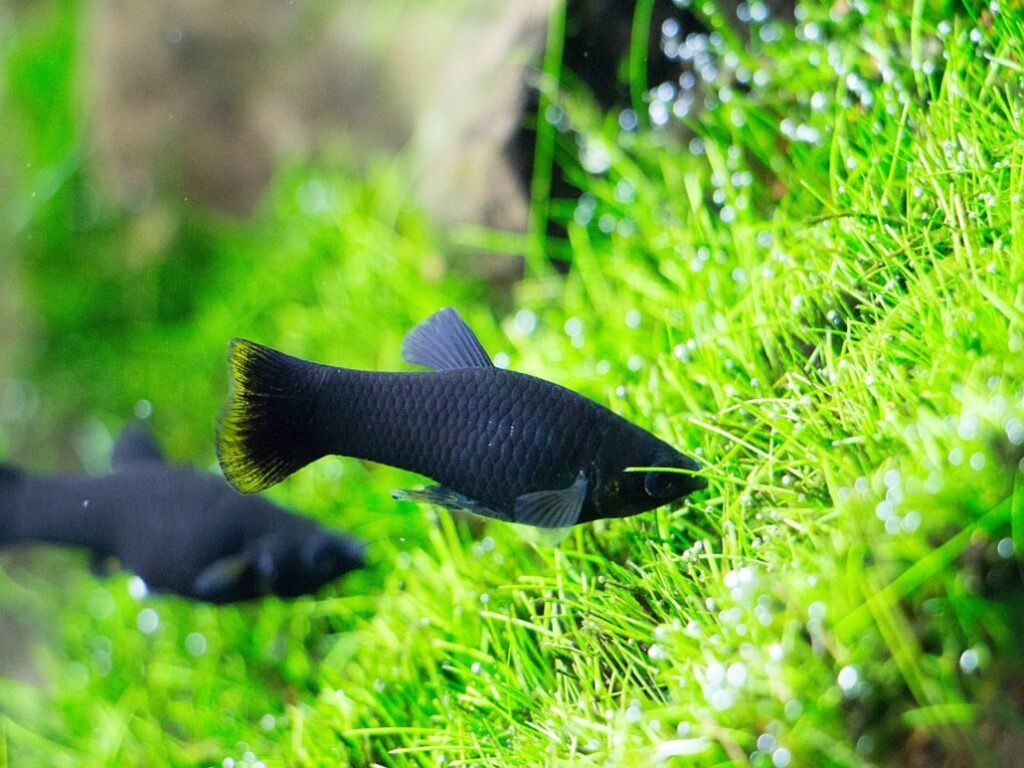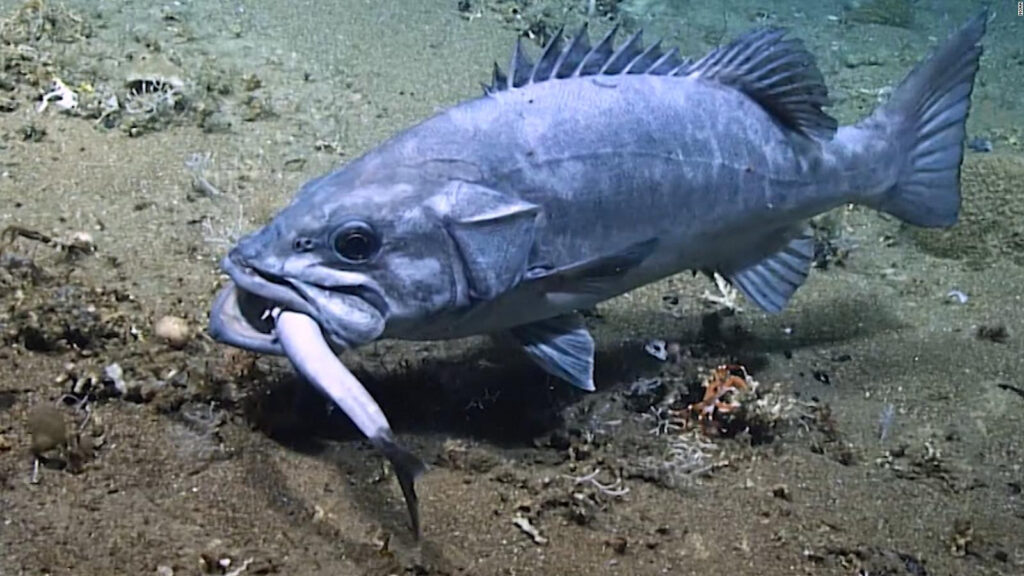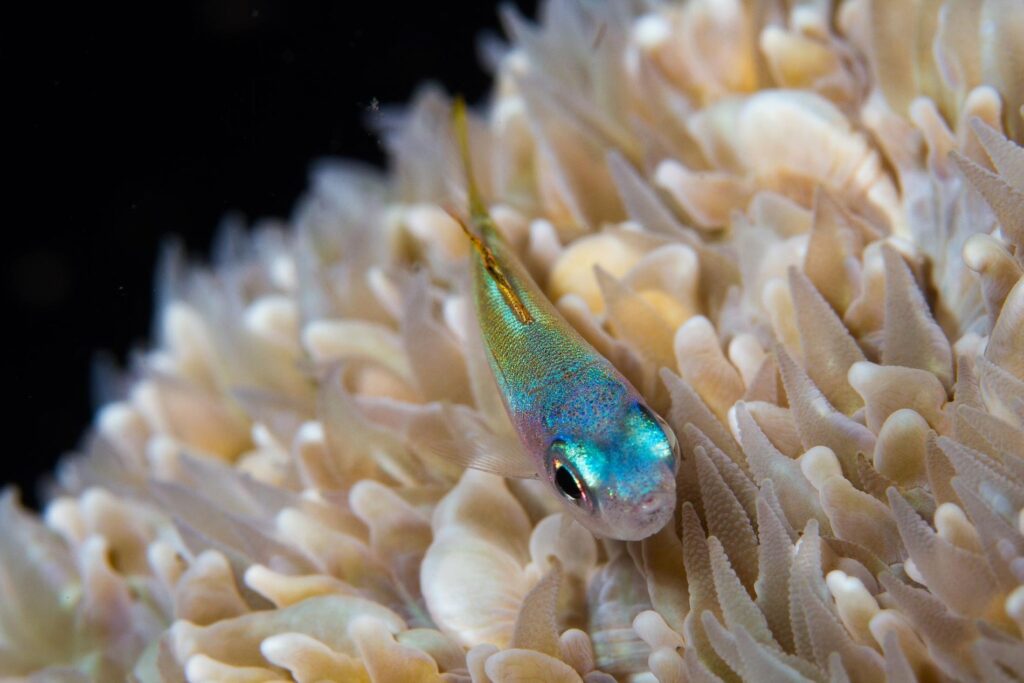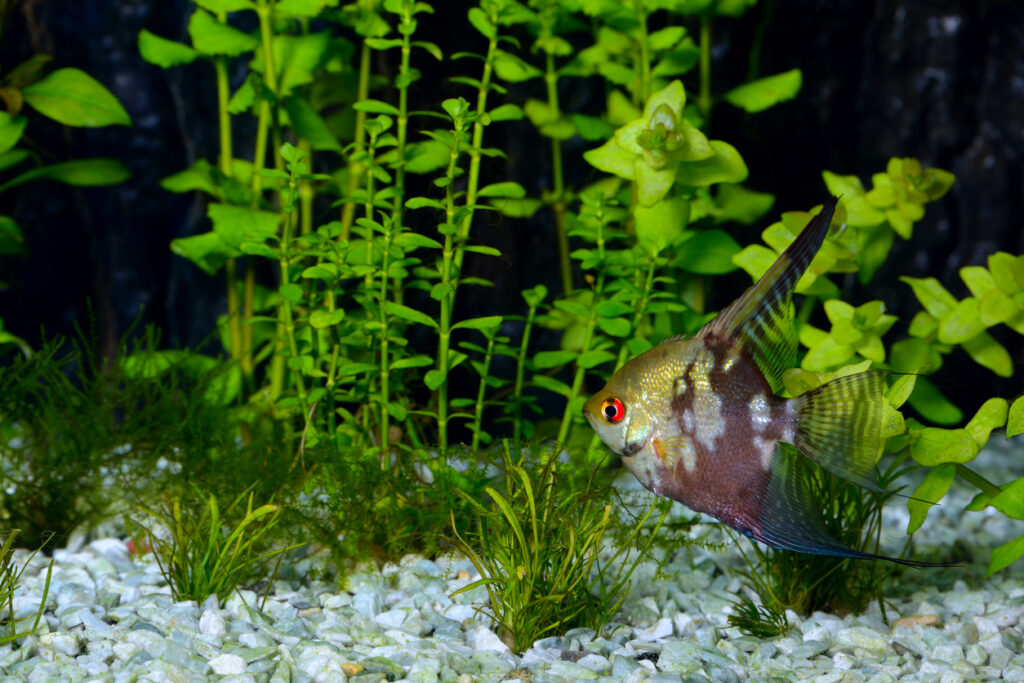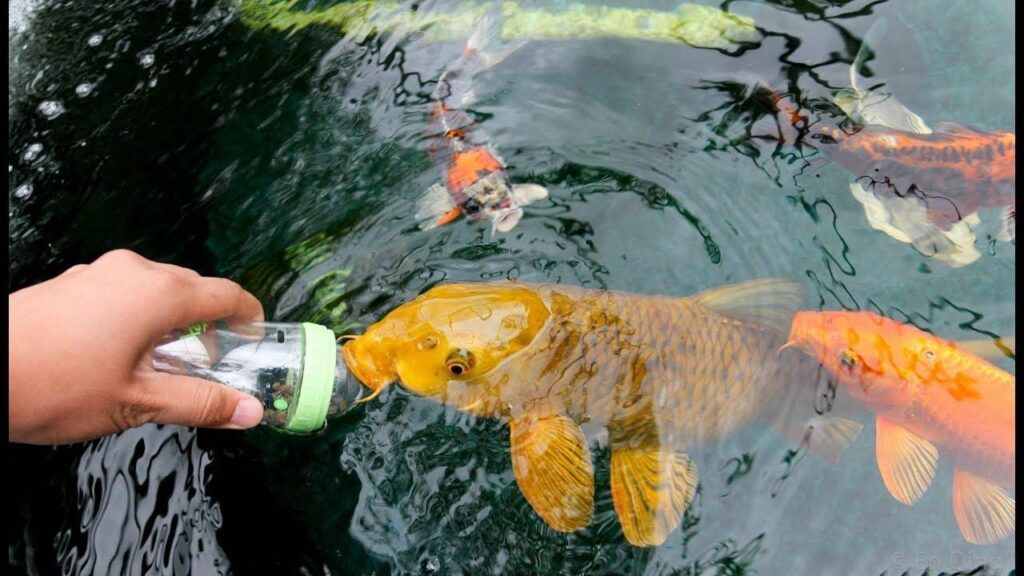As fish are animals whose existence is only aquatic, they have a very particular restriction when it comes to feeding, and that is that they can only take advantage of what their environment provides them. This does not prevent their eating habits from being sufficiently varied, much more than those of other animal groups. In this article we will know what fish eat, both those that are free and those that live in aquariums.
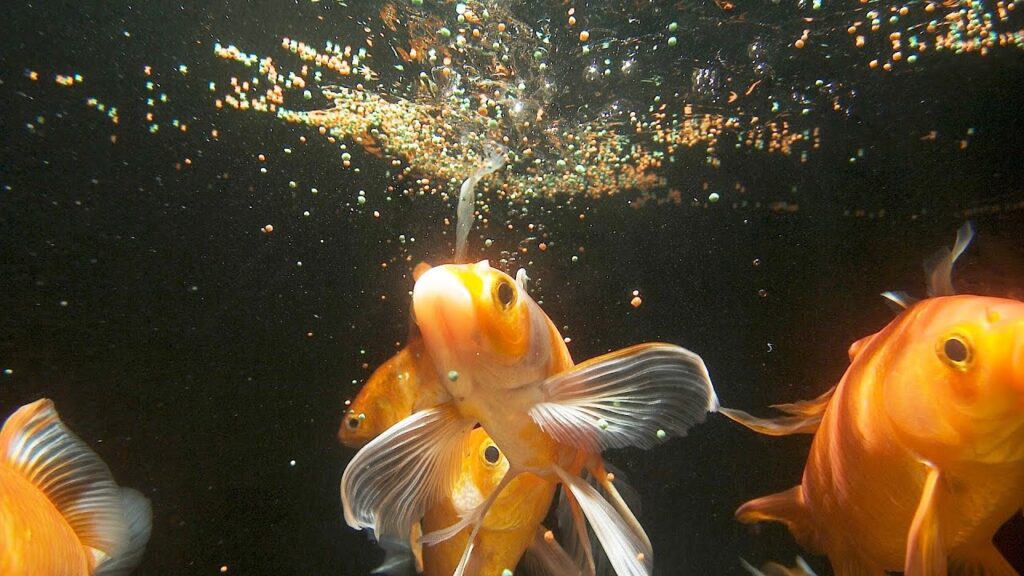
What do fish eat?
The fish is an exclusively aquatic vertebrate animal, which can moderate its body temperature according to its environment, being able to breathe through gills with which they trap dissolved oxygen in the water. It is usually covered with scales and has fins that are used to move around in the aquatic environment. The fish have developed their colonies both in the waters of mountain lakes and in the deep sea, by virtue of their various techniques when it comes to obtaining their food.
There are species of fish that feed on the decomposing remains of animals found on the ocean floor, others are active hunters, and still others subsist exclusively on plant matter. As we must understand, what serves as food for fish in the natural environment is not the same as what aquarium fish eat. In their natural environment, fish usually feed on other smaller aquatic species such as larvae or invertebrates. Most of them are carnivorous, although there are certain species whose diet is based on plants and algae.
When it comes to the food that fish kept in aquariums eat, it will depend on whether they are saltwater, freshwater, tropical or bottom fish. It is very important to know the diet of each particular species, in order to provide them with the right food that supplies them with the nutrients and vitamins they require to stay healthy and live for a long time.
If you want to know what are the types of food that fish consume, in the following paragraphs we will outline what fish eat, as well as what is constituted as something disparate or as a singular characteristic in the feeding of this animal group that populates the waters.
Types of Food
Depending on where the food comes from, fish can be classified into different categories, although it should be noted that many species can show more than one way of feeding and mix various modalities to obtain all the required nutrients.
On the other hand, there are species that can populate the mouths of rivers, where the waters are brackish and, therefore, can subsist both in rivers and in the sea, as is the case of the bull shark (Carcharhinus leucas) or the salmon (Salmo salar), so their diet will be complemented by the foods they can get in both kinds of environments.
This happens thanks to homeostasis, which is the quality that living beings have to maintain the internal chemical balance unchanged. In the following lines we will indicate the categories of fish according to the type of feeding they practice:
herbivore
Here are grouped those fish that feed on sources of plant origin, whether higher plants or algae, according to how deep they live and their lifestyle. Certain species have morphological adaptations in their body, such is the case of the parrotfish (Scarus coelestinus), which has a unique dentition that gathers its teeth in a structure similar to the beak of parrots, which it uses to gnaw the coral and rocks and thus be able to remove the algae from such surfaces.
carnivorous
Their diet is made up of other fish and aquatic varieties such as worms, crustaceans, molluscs and zooplankton. They may actively hunt or catch their prey by stalking. Additionally, they have teeth adapted to loosen the skin of their victims. Examples of them are the white shark (Carcharodon carcharias) or the giant barracuda (Sphyraena barracuda), both of which have sharp teeth that operate like real saws.
omnivorous
They are fish whose diet is more opportunistic and specialized, that is, they adapt to the availability of food, so their diet can be of both animal and vegetable origin. Examples include the red-bellied piranha (Serrasalmus nattereri), which, although it has a well-known reputation for being an insatiable carnivore, is not strictly so, since it can use vegetation to supplement its diet.
Another example of this is the common carp (Cyprinus carpio) which, in addition to feeding on aquatic vegetation, also seeks modest insects or crustaceans at the bottom of the river or lakes in which it lives.
detritivore
This is the name given to those fish that take advantage of the organic remains of other fish and that go down to the seabed. Thanks to them, organic material from aquatic environments is recycled, since in addition to providing food, numerous species help to filter the water, thus providing a highly relevant service for these ecosystems.
The catfish of the Siluriformes order are fish that have adapted for this type of feeding, such as the catfish (Panaque nigrolineatus). Likewise, the fish called pool cleaners, such as the Corydoras aeneus, which are responsible for filtering the bottom of the bodies of water where they live.
What do river fish eat?
River or freshwater fish are those that populate rivers, lakes, lagoons and wetlands, whose salinity (salt content) is less than 1.05%, which is decisive for their survival. River fish have body adaptations that enable them to live in low-salinity waters and their internal environment conserves these salts, since these are not very present in their external environment.
As we mentioned previously, there are different modalities by which they feed, so that among the species that populate the rivers (whose waters have a greater amount of phosphorus, potassium and magnesium) variations in their diets can also be achieved.
The species responsible for filtering the water base their diet on the residues of the river beds or lagoons, and live and sustain themselves at the bottom, since they have an adequate mouth apparatus for this. Other varieties, such as fluvial herbivores, subsist on the basis of algae, vegetables and microscopic species that make up the plankton. You also take advantage of fruits that fall into the water.
On the other hand, the carnivorous species that exist in this type of environment eat insect larvae or river crustaceans. They can also consume other more modest fish and, in certain cases, other land animals that fall unsuspectingly into the water.
What do sea fish eat?
Just as river fish, the species that populate seas and oceans, in whose waters sodium, iodine and chlorine abound, could not live in fresh water since their organism is not adapted to retain the salts that the body requires, such and as we already pointed out. Depending on how you have adapted to living with salt around you, your body is responsible for regulating its constant inflow and outflow.
Marine species incorporate a great diversity of foods into their diet. This will depend on their way of feeding (herbivores, carnivores, omnivores or detritivores) and where they live in the oceans. Such is the case of the inhabitants of the deep sea, such as abyssal fish and other species that have become accustomed to living in areas of the sea where life is not very present, which feed on zooplankton and tiny fish. However, other varieties, such as the deep-sea fish (Eurypharynx pelecanoides), can be predatory in nature and can catch larger fish.
On the other hand, species such as sharks, tuna or swordfish are pelagic varieties, that is, they reside closer to the surface. They are excellent hunters and predators, so they actively catch their prey. Other varieties, such as the clownfish (Amphiprion ocellaris), are classified as generalist omnivores, since their diet consists of both algae and animals in the same ratio. They have also been observed engulfing the parasites of the anemones that live with it, in a symbiotic association, that is, they reciprocally benefit to improve their lives.
There are also marine species with more curious eating habits, such as the pilot fish (Naucrates ductor), whose diet is made up of the remains of food and parasites of sharks, with whom they form an almost symbiotic relationship, since they are very rarely seen both separate.
What do aquarium fish eat?
Each aquarium contemplates a specific installation according to the type of fish that it is going to house. Aquariums can exist depending on the origin of the fish, whether they are cold water or tropical water, or their performance is surface or bottom, or their size is small or large, etc. And depending on the types of fish housed, their diet should be adjusted to them. Here are some of those categories.
Exemplars of Cold Water
Cold water fish are easy to care for and maintain. There is a multiplicity of foods for each species suited to their nutritional requirements and their digestive system. The most common are flakes, granules and flakes, which are complete formulas so as not to worry too much as they do not require any kind of supplement.
Flakes and scales are the most common food for cold water fish, since they remain afloat in the water for a certain time and are easily accessible to the animal. In contrast, the granules have a higher weight so they descend more quickly to the bottom of the aquarium, with the disadvantage that some less skilled fish cannot take advantage of them.
However, scale residues can very easily contaminate the water, so they must be cleaned more frequently so that it does not happen. The granules, on the other hand, leave little residue so they help maintain the balance of the aquarium. Cold water fish food is suitable for species such as goldfish, bubbleeyes, betta splendens, telescope fish, kite fish, Chinese neon or Koi carp.
Specimens of Tropical Waters
Tropical fish can be fed with live and dry food: the first of these could be made up of mosquito larvae, shrimp and modest earthworms; the second can come in flakes, granules, or tablets. Both provide a balanced supply of nutrients, fibers and proteins for perfect health.
Bottom Fish
The diet that is beneficial to bottom fish is not similar to that of those that swim on the surface. Flake food is not appropriate at this time as it requires some weight to sink to the bottom of the aquarium quickly and also not be swallowed by other fish as it falls.
We refer to species such as catfish (plecos, catfish), cobitids and barbels. Rounded tablets and discs are the food that is most supplied to these species since they have the appropriate weight so that they can reach specific areas of the fish tank.
discus fish
Discus are freshwater species highly valued for their beauty but with a rigorous diet that demands greater diversity in food. In addition to the traditional granules and flakes, there are supplements with vitamins that provide a high nutritional value and help improve your digestive system.
There are also color enhancers, which are designed to accentuate the intense color of discus fish through formulas prepared with a multitude of ingredients such as spirulina, green-lipped mussel, nettles, garlic, spinach and carrots. With them your fish will not only be healthy but they will also look splendid.
Small fish
Most minnows feed on larvae, invertebrates, and tiny aquatic animals. On the other hand, they need to consume more food than their large counterparts (in relation to their size), since their energy requirements are greater, due to their high metabolism and activity.
In the case of fry, that is, those young and small fish, their diet is made up of microscopic algae and plankton, since the size of their mouth does not allow them to consume large foods. As they grow, their eating habits change until they eat like an adult fish.
The Best Food for Aquarium Fish
Providing the proper food for aquarium fish is a major concern for every aquarium lover. The challenge is to get the right feed so that the health of the fish is not affected by poor feed. All properly fed fish is a healthy fish and will not face problems in the aquarium.
We have to keep in mind that the fish we have in the aquarium have different origins and we are not only referring to their natural origin, which can also have an influence on their diet. While some fish (those most commercialized and easy to obtain in captivity) come from farms and are used to being fed processed food, others come directly from nature, where they sought a totally different diet than the one they used to eat. we can provide them.
To provide them with a proper diet, we must know what habitat they came from and what they ate when they were free. You cannot give the same food to cold water fish, tropical fish, marine fish or bottom fish, since each of them demands a different diet. Depending on the habitat that we have recreated in the aquarium, it may happen that we have fish with different eating habits, so we must treat them differently.
The total responsibility of knowing their requirements and providing them with the necessary nutrients lies with the caregivers. The healthiest foods for fish should primarily incorporate:
- Amino acids (supply protein)
- Fats (supply fatty acids)
- Carbohydrates (supply cellulose)
It is of great importance not to provide excess food to the fish, since unconsumed residues can affect the quality of the water and therefore cause diseases. The most convenient thing is to give them food several times but in small quantities.
Different Types of Food
On sale you can get various types of fish food that are already prepared and whose preparation we do not have to take care of. However, if we have time and we wish, there are some homemade fish food recipes that can be prepared. Among them we can differentiate five different kinds of fish food:
Living
Traditional live food for aquarium fish consists of daphina or brine shrimp (modest crustaceans), bloodworms, shrimp and tubifex (tiny worms). You can also buy kits with fertile artemia eggs, to set up an artemia hatchery at home and constantly have live food for the fish.
Lyophilized
A large part of live foods are not easily available, but those that are available to us are those that have previously been freeze-dried. This is a drying technique by means of which the food does not lose its nutrients, being equally delicious for the fish. In addition, under this procedure, they are free of parasites and pathogens and constitute an extraordinary protein supplement for your aquarium fish.
Dry
Dry foods are the most widely used in any of their presentations, flakes, flakes or granules and their manufacturing process involves the extraction of any moisture from them. Its content may vary according to the species of fish to which it is going to be supplied, and may include all kinds of food, from algae to crustaceans for carnivorous species. One of their greatest advantages is that they are usually enriched and are the perfect supplement for a balanced diet, which should include live and fresh foods.
cool but not alive
Certain fish are pleased by the inclusion in their diet of modest pieces of mussels, shrimp, fish, even chicken or animal entrails. They should not be the basis of their diet, and we must be very careful with "what" kind of food we use, which must always be in accordance with the species of fish present in the aquarium. Likewise, one must be cautious in allowing the accidental introduction of some kind of parasite.
Frozen
Frozen fish food is regularly mosquito larvae, worms, water fleas, crustaceans, shrimp, etc. (daphnia, tubifex, artemia), which can be purchased in certain specialized stores. They come to be the ideal replacement in case of not being able to supply live food. They must be thawed beforehand, and wait until it reaches room temperature so that it can be introduced into the aquarium.
holiday food
When the aquarium keeper is going away for a short time, the fish can be left with a special block of food, which only dissolves when the fish eat it and can last up to three days. If the absence is going to be longer, you can leave them some tablets that can last up to 14 days and dissolve only when the fish eat them, with the additional advantage that they do not cloud the water and without worrying about their feeding. There is also the alternative of an automatic feeder that regulates the doses and the time in which the food is supplied.
Food with Medicines
When it comes to medicating aquarium fish, the administration of medications through food can be used as a method, without contaminating the tank water.
How many times are fish fed in an aquarium?
When it comes to supplying food to fish in an aquarium we have to be attentive to how they eat in the wild. This should be done in small portions throughout the day. If it is not possible for us to be able to do it between four and six times a day to give them small doses, what we can do is take it as many times as each one can give them each day, two or three depending on the case.
What amount of food is supplied?
In this regard, the concept is extremely clear: what they can eat in a couple of minutes. It is much more convenient to give them little than too much. Therefore, the method that we will use to guide us will be to place a crumb of food on the water and calculate how long it will take to finish it, if the food disappears in less than a couple of minutes we can add a little more.
If there is food left over, it is best to remove it. It is important that the food does not stay afloat or go to the bottom since two things could happen that we really do not want. You could be overfeeding the fish or dirtying the water.
You may also be interested in these other articles:
